I once did a personal branding photoshoot for a client. Almost as soon as I had sent the gallery through I got a reply from her saying she LOVED them… but 24-hours later I got another email with some unexpected negative feedback.
She said that although the photos were beautiful they didn’t fit with her brand, and therefore most of them were unusable for her business –– which was precisely the point of the shoot.
Well, I was pretty gutted… and then confused, and then a tad annoyed, and then angry, and then sad, and then… I took a deep breath.
I’m so pleased I took that moment and planned what I was going to do next. Everything I did ended up being really valuable and resulted in a positive resolution for me AND the client.
So here is the framework I use for handling negative feedback.
Don’t Respond Right Away
That whole host of mixed and unpleasant emotions you are feeling… not the right headspace to handle a business transaction in. Because although the feedback may feel personal, it isn’t. It’s a work-related setback.
So, take those deep breaths and step away from the situation for a while. Whether it’s by email or in a call acknowledge you have received the message and specify you need some time. Say something along the lines of ‘thank you for letting me know, I’m sorry you feel that way. Let me get back to you later today/tomorrow with a solution’.
Clarify the Issue
But before you go check you are 100% sure what the problem is –– rephrase it and repeat it back to the client. Not only does this mean you are clear on the matter, but it also restores your agency by actively engaging with the issue straight away.
Get Some Advice
Reach out to someone in your freelance support network and ask if they have ever experienced negative feedback or what they would do in your situation.
Not only does an outside perspective offer valuable insight, but talking it out just makes things easier!
Put Yourself in the Client’s Shoes
Understand the situation from your client’s perspective, including the investment they have made, and how you would feel if something similar happened.
Not only does empathetically evaluating it make it easier to understand where things might have gone wrong, but I also find that it takes the sting out of the experience a little. It really isn’t personal.
What If You Disagree?
If you are confident that you did the job as specified, then go back through all your client interactions and, taking notes, clearly formulate why this is the case. When you go back to the client emphasise that you took the time to reflect and be able to show why you did the job as agreed.
Be calm, polite, graceful –– but firm.
Learn From the Experience
Ask yourself if there is anything you could do to prevent this from happening again.
For me, it has meant that I spend extra time on the initial client consultation and preparing, whether it’s for personal branding photography, product photography or even website development. I even wrote a client guide on how to prepare for a personal branding photoshoot.
Learning from setbacks is part of cultivating a growth mindset.
Find An Amicable Solution
Contrary to the saying, the customer is not always right –– but I do believe that it is your job to present a solution that works for both of you. This might take the form of a do-over, a partial refund, or just a truly heartfelt apology.
In my situation, I happened to be running a series of mini photoshoots in the same city as her a couple of weeks later. I offered her a slot so we could take some more photos that were more in line with what she envisioned.
This solution meant I lost minimal income, I felt better about fulfilling the original job requirements, and the client appreciated my willingness to find a resolution that left her with pictures she would now use.
Not only does an amicable solution feel better for everyone, but it also speaks to your professionalism and ability to evolve in a business setting.
At worst negative feedback is an upsetting annoyance but, at best it is an opportunity to grow, learn and find out that criticism really isn’t as bad as you might think!




0 Comments